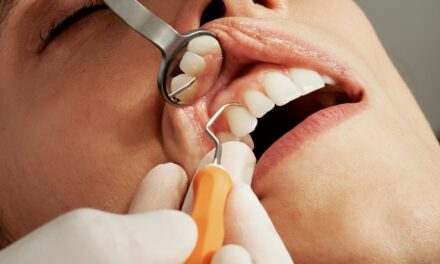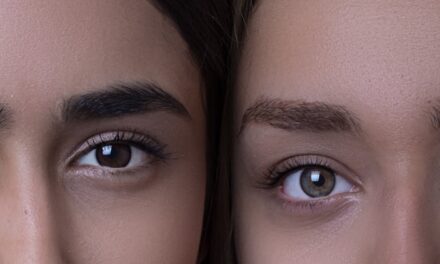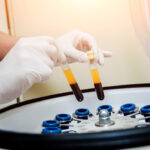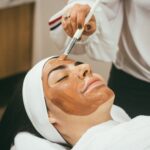The year 2021 was pretty on-point when it came to skin trends. We saw ‘game-changing’ hacks, including using saran and vaseline to MELT blemishes – yes really! But honestly, looking at 2022 things are about to get even weirder. Did you know Salmon Sperm could be the secret to a youthful glow!?
Here, we have asked the experts to weigh in on skincare trends, and give us a sneak peak of what we can expect to see this year, from the weird and wonderful to downright bizarre.
Salmon Sperm
Ok! Hear us out on this one. Before you let your imagination run wild, we’re not about to tell you to slather fresh fish sperm all over your face, but it might just be the secret to that youthful glow we strive for.
Hagen Schumacher, a leading Consultant Plastic Surgeon at Adore Life explains that some studies have shown that the DNA found in Salmon sperm could aid cell turnover, leading to a glowy, more youthful complexion.
He says: “This trend first started in Korea, but we have seen it slowly filter down into some luxury skincare brands, including Arentum’s la potion infinie.
As we age, the skin naturally loses its collagen and elasticity, which may make the skin appear dry, thin and dull with more pronounced fine lines and wrinkles, this is where Salmon Sperm is said to help.
When we say Salmon sperm, what we are actually referring to is the DNA found within it. It is said to have very potent regenerative qualities, and its ability to penetrate the deeper layers of skin means it helps to encourage healthy cell turnover and maintain elasticity for a brighter, tighter complexion.”
Of course if you’re not quite ready to take the plunge and add Salmon sperm to your nightly moisturiser, there is an all new anti-aging treatment available called Polynucleotides that is derived from that salmon fishy goodness that is set to make waves this year.
Dr Ryan Hamdy, Medical Doctor and Trainer at RegenLab explains: “Polynucleotides is an innovative new concept in regenerative, biostimulation treatment that is derived from salmon sperm. Perfect for those who have noticed a loss in elasticity and are struggling with the signs of ageing skin.
Following treatment, the skin is exposed to the biostimulation process as a result of the therapy. The regenerative process begins, and the skin gets thicker and firmer because of the antioxidant and hydrating properties of the Salmon DNA. Small wrinkles are minimised, and the skin becomes brighter and more even-toned.”
Skinnimalism!
Let’s face it, none of us have the time for a rigorous 20 step skincare routine. The good news is, this year experts predict that we are likely to see a bigger shift towards ‘Skinnimalism’ (skin and minimalism).
Dr Julietta Gusarova, Medical Doctor and Trainer at RegenLab explains that the world of skincare has become a maze. For better results we should be stripping it back, focusing on essentials, and cleverly combining active ingredients.
She says: “Active ingredients are essential for healthy skin, but they don’t need to be standalone products. Single, mass-manufactured actives can be costly, time-consuming, and ineffective because of low potency levels. When combined, certain actives work harmoniously together and enhance the effects of one another. This means you get the results you want faster.
Niacinamide, a popular ingredient for those with oiler skin types is a derivative of vitamin B3 but paired with ceremide’s, its hydrating, and protective properties are amplified. Similarly, hyaluronic acid, which helps to lock moisture in the skin can also boost the anti-aging effects of retinol.
A lot of skincare brands are starting to combine active ingredients, for example, Farewell Skin. They combine active ingredients with a stabilised mixture of high and low-molecular-weight hyaluronic acid to target specific skin concerns. Not only is this a much more tailored approach to skincare, but it also delivers faster results.”
Enter the (Cellular) Matrix
Regenerative medicine and PRP is not entirely new, in fact it is tried, tested and loved by a number of A-listers from Kim Kardashian and Angelina Jolie. However, it has been revamped for even better results. Enter Cellular Matrix.
Dr Ryan Hamdy, Medical Doctor and Trainer at RegenLab explains: “The concept of PRP is rather simple, it works by drawing a blood sample from your body and spinning it to separate the plasma. This is then injected to help increase skin volume and instantly rejuvenate tired looking skin.
Cellular Matrix takes that concept one step further and combines platelet-rich plasma with hyaluronic acid for an instant lift. The hyaluronic acid helps to plump and add volume to the skin, whilst smoothing out fine lines and deep set wrinkles.
A big plus from using Cellular Matrix is that firstly it is non-invasive, there is little to no downtime and secondly, it works wonders around the eyes!
Hagen adds: “PRP has actually been around for centuries. Back in the 90’s it was used to treat broken bones and spinal injuries to speed up the healing process. It has even been used in plastic surgery with microneedling and fat grafting procedures.
10 years ago, there was a lack of good quality data when it came to regenerative medicine, especially PRP. As time has evolved, studies are now a lot more robust.”
Tailored Made Solutions
Whilst the market is flooded with new ingredients every day, it is important to remember that your skin is unique. No skin is the same, and we each have different concerns. Ultimately, for the best results that means our skincare regimes needs to be tailored.
Hagen Schumacher, Consultant Plastic Surgeon at Adore Life adds: “Of course, nowadays there are a lot of surgical and non-surgical ways to achieve youthful looking skin, but you would be surprised how much the correct skincare regime could help.
Whether you are trying to rebalance your skin, improve acne, or fight pigmentation, your skincare routine should be bespoke and tailored around your individual needs. We each have different chemical and genetic differences within our bodies, meaning some skincare products may be totally incorrect, ineffective, and may even cause irritation.”
Coming back to combining actives, this is key to customizing a skincare routine around your exact needs. If you have multiple skincare concerns, each one of those concerns can be targeted with just one product that contains carefully selected ingredients at a high concentration.
Another key benefit of simplifying your routine, and opting for a more tailored solution, is a reduced risk of irritation. When you use products specially formulated for your needs, you will be able to identify any sensitivities you may have.
Dr Julietta Gusarova adds: “If you suffer from skin conditions such as eczema, psoriasis or contact dermatitis, you may find it easier to shy away from skincare, but actually a tailored approach may be beneficial for you. Consult a professional to help you to understand where your sensitivities lie, and from there, you will be able to formulate a solution that targets your concerns, irritating your skin.”
Mild Retinols
Retinol is no new notion in the world of skincare, but it is a trend that is here to stay. Derived from vitamin A, retinol has been proven to help treat fine lines, pigmentation, and even acne.
Mel says: “Retinol has been a staple in skincare for years. By promoting surface skin cells to renew, it helps to promote cell growth beneath the surface, this, in turn, helps to retain collagen levels, boost radiance, and thickens the deeper layers of skin to help delay the formation of wrinkles.
Typically, retinol is used as part of an evening skincare routine but try to be careful with it and introduce it to your routine slowly, especially if you have sensitive skin. As retinol is effective in promoting cell turnover, it can cause temporary irritation to the skin, including peeling and redness.
If you are new to retinol, I would advise starting at a low concentration, three times per week and building up from there. To reduce the risk of irritation, you may want to prioritise hydration and ensure you are wearing a good SPF each day. I would recommend getting a retinol product that is enriched with hyaluronic acid, like Farewell Ageing Skin to really help lock in moisture, minimise any irritation, and amplify the effects of retinol.”
More Variation in SPF
Like retinol, SPF is no new notion in skincare, and it is one a staple product that you should NEVER skip. However, in the spirit of keeping things simple, this year we are likely to see more variations in formulation.
Hagen explains that even when it is snowing, the sun still emits invisible radiation that is extremely damaging to the skin.
He says: “Whilst the sun is a provider of vitamin D, which helps to regulate calcium within the body, the sun emits powerful UVA and UVB rays which are extremely bad for the skin. Overexposure to these rays causes pigmentation, severe irritation, and even Melanoma.
Whilst UVB rays directly impact the skin’s surface causing red, itchy, painful rashes, UVA rays which you won’t feel, penetrate the deeper layers of skin causing skin cells to become abnormal, and break down your vital support substances, such as collagen which keeps your skin healthy.
At the moment, the market is saturated with cream SPF products, but as we move towards a more simplistic skincare routine, I think we will begin to see more SPF sprays, or booster serums that are a little more user friendly and allow for on-the-go use.”
Dr Julietta Gusarova adds: “It is worth noting that UVB rays are most intense between the hours of 10:00 AM and 4:00 PM, and UVA rays are present all day at a consistent level. I recommend using SPF 30 or above every day to ensure your skin has that first level of protection. Without it, the damage to your skin could result in premature ageing, pigmentation, acne, and more complex skin conditions. Remember, even if you are not going outside, harmful rays can still penetrate windows, people often forget this.
Hyaluronic Acid – It’s Here to Stay
Hyaluronic acid (HA) is not just a trend. In fact, in recent years, it has become an OG product, and a firm staple, not just in skincare but also in cosmetic procedures, including dermal fillers and Cellular Matrix injections.
Suitable, and highly effective for all skin types, hyaluronic acid really is one of the best skincare ingredients you can use.
Hagen explains: “It’s clear to see that Hyaluronic acid is here to stay. In 2022, I think we will see more and more brands infusing skincare with higher concentrations of HA, and we’ll see fewer stand-alone HA products as we embrace more simplistic target-specific skincare.”
Hyaluronic acid is a glycosaminoglycan, which means it is a naturally occurring substance and forms part of the skin’s youth-supporting matrix. It works to stabilise, safeguard, and renew the skin, keeping it hydrated and glowing.
Considered a humectant, hyaluronic acid draws moisture from its surroundings, and its large molecular structure allows it to hold up to 1,000 times its weight in water which helps the outer layers of the skin retain moisture.
Hyaluronic acid can also help to improve the overall elasticity of the skin. Studies have shown that regular use within everyday skin care can reverse the signs of ageing by smoothing fine lines and wrinkles for a more youthful, plump appearance.”
Dr Julietta Gusarova adds: “Most good moisturisers do contain a percentage of hyaluronic acid nowadays, but it is important to understand how much is in there, and where it sits on the ingredient list. For best results, I recommend opting for formulas that are based on hyaluronic acid, this will ensure your skin is receiving an effective concentration, and it can enhance any other actives that might be present.”
No matter if you’re ready to dive into Salmon sperm, or enter the Cellular Matrix – 2022 is certainly shopping up to simplify skincare. Remember though, skincare is personal and you always take the time to listen to your skin, and identify its exact needs. If you need help, you should always seek professional advice.


















